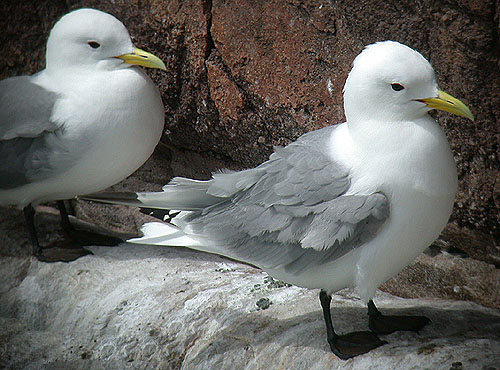(OBI link removed) |
(Juvenile & Flight photos added. ID re-written as original a copy. Referenced. Bird Song category) |
||
| Line 1: | Line 1: | ||
| − | [[Image:Black-legged_Kittiwake.jpg|thumb|550px|right|Photo by JJM]] | + | [[Image:Black-legged_Kittiwake.jpg|thumb|550px|right|Photo by {{user|JJM|JJM}}]] |
;[[:Category:Rissa|Rissa]] tridactyla | ;[[:Category:Rissa|Rissa]] tridactyla | ||
| − | |||
==Identification== | ==Identification== | ||
| − | 40cm | + | 40cm<br /> |
| + | '''Summer Adult''' | ||
| + | *White, with silver-grey mantle and wings | ||
| + | *Wing tips black ("dipped in ink look") | ||
| + | *Bill yellowy-green | ||
| + | *Legs blackish | ||
| + | *Orange orbital ring | ||
==Distribution== | ==Distribution== | ||
| + | [[Image:Kitti 10U2461.jpg|thumb|350px|right|Photo by {{user|rentoncharman|rentoncharman}}<br />[[Bempton Cliffs]], [[Yorkshire]], [[England]]]] | ||
Breeds around [[Iceland]], the [[Faroes]] and [[Britain]] (absent from much of south and east where coasts lack suitable cliffs), coastal [[Norway]] and the north of the Kola Peninsula. In the far north breeds on [[Jan Mayen]], [[Svalbard]], [[Bear Island]], [[Franz Josef Land]] and [[Novaya Zemlya]]. Also breeds locally in small numbers in north [[Denmark]] and [[Germany]], the [[Channel Islands]] and north-west [[France]], the north-western tip of [[Spain]] and at one site in [[Portugal]]. | Breeds around [[Iceland]], the [[Faroes]] and [[Britain]] (absent from much of south and east where coasts lack suitable cliffs), coastal [[Norway]] and the north of the Kola Peninsula. In the far north breeds on [[Jan Mayen]], [[Svalbard]], [[Bear Island]], [[Franz Josef Land]] and [[Novaya Zemlya]]. Also breeds locally in small numbers in north [[Denmark]] and [[Germany]], the [[Channel Islands]] and north-west [[France]], the north-western tip of [[Spain]] and at one site in [[Portugal]]. | ||
Colonies occupied March (earlier in the south)-September, disperse after breeding and in winter occurs in the Atlantic from breeding range south to about [[Morocco]], in the North Sea and the Mediterranean east to Italy. | Colonies occupied March (earlier in the south)-September, disperse after breeding and in winter occurs in the Atlantic from breeding range south to about [[Morocco]], in the North Sea and the Mediterranean east to Italy. | ||
| − | Has occurred as a vagrant to most European countries, [[Malta]], the [[Middle East]] including Aqaba in [[Jordan]], [[ | + | Has occurred as a vagrant to most European countries, [[Malta]], the [[Middle East]] including Aqaba in [[Jordan]], North [[Africa]], [[Canary Islands]] and [[Cape Verde Islands]]. |
==Taxonomy== | ==Taxonomy== | ||
| + | [[Image:Kitti Juv IMG 3671.JPG|thumb|350px|right|Photo by {{user|Geoff+Pain|Geoff Pain}}<br />Juvenile, [[Bempton Cliffs]], [[RSPB]], [[Yorkshire]], [[England]]]] | ||
There are 2 subspecies: | There are 2 subspecies: | ||
| − | * ''R t tridactyla'' | + | * ''R. t. tridactyla'' |
| − | * ''R t pollicaris'' | + | * ''R. t. pollicaris'' |
==Habitat== | ==Habitat== | ||
Breeds on steep sea-cliffs, stacks and rocky islands, in some areas also on buildings. When not breeding occurs at sea often far from land. Sometimes seen at freshwaters near the coast or far inland after severe weather. | Breeds on steep sea-cliffs, stacks and rocky islands, in some areas also on buildings. When not breeding occurs at sea often far from land. Sometimes seen at freshwaters near the coast or far inland after severe weather. | ||
==Behaviour== | ==Behaviour== | ||
It nests only on cliffs. | It nests only on cliffs. | ||
| − | |||
====Vocalisation==== | ====Vocalisation==== | ||
<flashmp3>Rissa tridactyla (song).mp3</flashmp3><br /> | <flashmp3>Rissa tridactyla (song).mp3</flashmp3><br /> | ||
''[[Media:Rissa tridactyla (song).mp3|Listen in an external program]]'' | ''[[Media:Rissa tridactyla (song).mp3|Listen in an external program]]'' | ||
| + | ==References== | ||
| + | #Collins Pocket Guide to British Birds 1966 | ||
==External Links== | ==External Links== | ||
{{GSearch|Rissa+tridactyla}} | {{GSearch|Rissa+tridactyla}} | ||
| − | [[Category:Birds]] [[Category:Rissa]] | + | [[Category:Birds]] [[Category:Rissa]][[Category:Bird Songs]] |
Revision as of 15:45, 22 March 2009

- Rissa tridactyla
Identification
40cm
Summer Adult
- White, with silver-grey mantle and wings
- Wing tips black ("dipped in ink look")
- Bill yellowy-green
- Legs blackish
- Orange orbital ring
Distribution
Breeds around Iceland, the Faroes and Britain (absent from much of south and east where coasts lack suitable cliffs), coastal Norway and the north of the Kola Peninsula. In the far north breeds on Jan Mayen, Svalbard, Bear Island, Franz Josef Land and Novaya Zemlya. Also breeds locally in small numbers in north Denmark and Germany, the Channel Islands and north-west France, the north-western tip of Spain and at one site in Portugal.
Colonies occupied March (earlier in the south)-September, disperse after breeding and in winter occurs in the Atlantic from breeding range south to about Morocco, in the North Sea and the Mediterranean east to Italy.
Has occurred as a vagrant to most European countries, Malta, the Middle East including Aqaba in Jordan, North Africa, Canary Islands and Cape Verde Islands.
Taxonomy
There are 2 subspecies:
- R. t. tridactyla
- R. t. pollicaris
Habitat
Breeds on steep sea-cliffs, stacks and rocky islands, in some areas also on buildings. When not breeding occurs at sea often far from land. Sometimes seen at freshwaters near the coast or far inland after severe weather.
Behaviour
It nests only on cliffs.
Vocalisation
<flashmp3>Rissa tridactyla (song).mp3</flashmp3>
Listen in an external program
References
- Collins Pocket Guide to British Birds 1966





